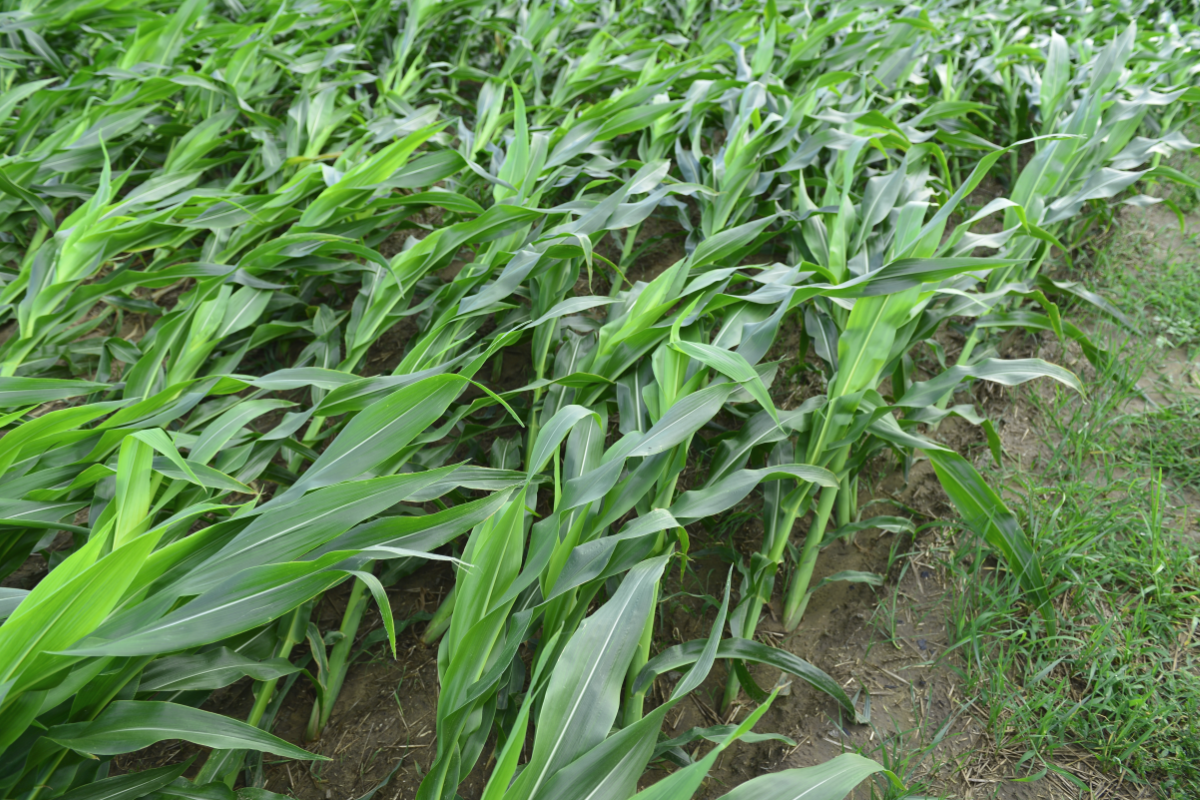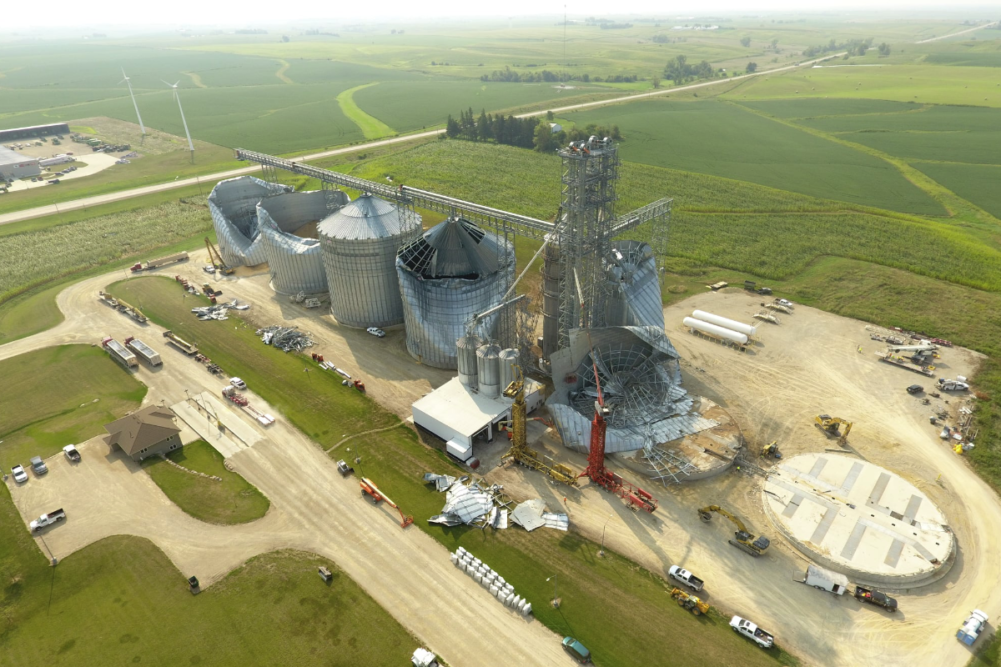DES MOINES, IOWA, US — Iowa’s grain storage facilities are picking up the pieces following the severe “derecho” storm that swept across the state on Aug. 10. Grain storage bins throughout Iowa were crushed as if they were empty soda cans.
“The derecho storm dealt another gut punch to Iowa farmers, wiping out whole fields, demolishing grain bins and other farm buildings,” said Kim Reynolds, governor of Iowa.
The storm unleashed winds of over 100 miles per hour, equivalent to an F1 tornado. Some have described it as an inland hurricane.
Steve Sukup, president and chief executive officer of Sukup, spoke with World Grain about the durability of bins.
“Sukup Manufacturing Co. has nine professional engineers on staff plus 20 degreed engineers to design our products to meet industry standards,” Sukup said. “No structures are immune to damage at those wind speeds. Our bins are engineered to withstand wind speeds of 105 miles per hour, which typically is more than adequate.
“As a family-owned and operated company we hate to see all the damage to farms and crops, knowing how that loss will impact the ag community.”
The Iowa department of agriculture estimates more than 57 million bushels of permanently licensed grain storage was seriously damaged or destroyed. The department consulted with several commercial co-ops in Iowa who believe it will cost more than $300 million to remove, replace or repair the damaged grain storage bins.
“We lost structures no doubt,” said Charles Hurburgh, professor of agricultural engineering for Iowa State University. “We lost elevators, whole elevators. The big bins paid the price if they were empty. The smaller ones typically did not. Because of the methodology of the downdraft of the wind and then going back up into the clouds, it tore the roofs off and then you have this characteristic cave in.
“The takeaway is the amount of storage that was destroyed is less than the amount of grain production that was destroyed, which means we will probably not have a total storage shortage.”
But storage challenges remain. Hurburgh explained the grain could be in the wrong position at times, meaning if a producer originally planned to deliver grain to a now-destroyed elevator, they may incur extra transportation costs or the elevator may have to move a second time.
Before the storm, the US Department of Agriculture’s (USDA) National Agricultural Statistics Service (NASS) estimated Iowa’s 2020 corn production to total 2.737 billion bushels and 15.278 billion bushels for the country as a whole.
Grain from the storm area will need to move to the market as quickly as possible because of quality concerns, he said.
“I think shipping is going to be more common because the grain quality is not going to be the best and that’s not a good thing to put in piles and bunkers anyway,” Hurburgh said. “I do not think there will be that much additional demand for pile storage.”
Hurburgh does not encourage farmers to make piles.
“Small piles go bad worse than big ones and piles take more, constant management,” Hurburgh said.
Many grain elevators and storage sites have assessed the damage and have begun the recovery process. Plans include demolition of unsalvageable storage bins, equipment and the addition of new ones.
Mid-Iowa Cooperative, a member-owned cooperative serving over 1,400 members across Iowa, had nine out of 14 grain locations affected by the storm and evaluated for next steps. The cooperative lined up demolition crews to tackle the damage, ordered bins and are working with builders to get the sites ready for the 2020 grain harvest.
Mid-Iowa Cooperative’s Midway location was damaged 80% with one bin standing and most conveyors and grain legs remaining. The first replacement bin is expected to arrive in early September to begin construction. A 30,000-bushel leg and conveyor system and 2-million-bushel ground pile will be added to the Midway site.
Before the storm, Mid-Iowa Cooperative already had planned to add 3.6 million more bushels on the ground. The cooperative also assured members it would be ready for the 2020 grain harvest.
The Key Cooperative also sustained loss from the storm. The member-owned cooperative serving more than 1,700 farmers and 10,000 customers in 13 communities across the state of Iowa, experienced “significant damage” to 10 of its 15 grain locations.
“So out of our 30 million licensed storage, we have 40 bins that were damaged, and that represents about 12 million bushels of space, and about 20 of those bins were completely demolished, which represents roughly 6 million bushels of space,” said Boyd Brodie, general manager of Key Cooperative. “We’re also in the process this year of adding about 3.5 million bushels of space around the company, anticipating some significant yields prior to the storm. And we’ve also brought in another 3 million bushels of emergency bunker storage that we’re placing strategically around at our locations to help with the harvest.”
As of Dec. 1, 2019, Iowa’s off-farm storage facilities capacity was 1.51 billion bushels, according to NASS. The state’s on-farm storage capacity was 2.10 billion bushels, making Iowa’s total storage capacity 3.61 billion bushels.
Despite the destruction, the grain storage industry has not missed a beat by focusing on recovery and repair with an eye on the upcoming 2020 harvest.

According to the USDA’s Risk Management Agency (RMA), approximately 8.2 million acres of corn and 5.6 million acres of soybeans were impacted by the storm in Iowa.
Hurburgh noted that the damage to Iowa’s corn crop is not a “national disaster.”
“The states around are doing well, and the availability of good quality corn should be pretty good,” Hurburgh said. “It just so happens that Iowa was sitting in the wrong place at the wrong time after what started out to be the best crop prospect we’ve ever had.”
The state’s corn crop has been challenged with not only the derecho but also a persistent drought.
“The drought in west central Iowa will reduce the amount of grain but we don’t know exactly how much,” Hurburgh said. “If we take some analogy from 2012, which is the last time we had a drought year like this, we were looking somewhere about 20% to 25% reduction in yield in the drought areas. In the total, I imagine over 40% of the crop area of Iowa has been subject to one or more yield reductions because of the drought and the storm this year.”
In the USDA’s Aug. 27 drought monitor map report areas of severe drought (D2), moderate drought (D1), and abnormally dry (D0) expanded in Iowa.
“In central and western Iowa, farmers are experiencing significant impacts from below-normal precipitation during the past 60 days (3-to-7+ inch deficits) and from the devastating impacts of the derecho event (straight-line wind storm) on Aug. 10 and 11 that caused severe damage to the state’s corn crop,” the USDA drought monitor report said.
Iowa’s 2019 corn production was estimated at 2.58 billion bushels, according to a USDA NASS Crop Production 2019 summary report. The report noted that Iowa has led the United States in corn production for 26 consecutive years.






